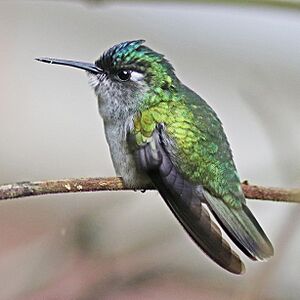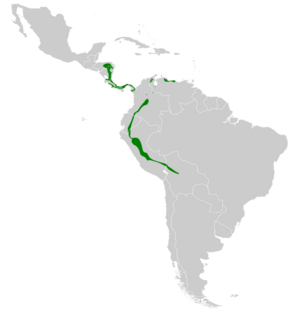Violet-headed hummingbird facts for kids
Quick facts for kids Violet-headed hummingbird |
|
|---|---|
 |
|
| Female in eastern Ecuador | |
| Conservation status | |
| Scientific classification | |
| Genus: |
Klais
|
| Species: |
guimeti
|
 |
|
| Range of K. guimeti | |
The violet-headed hummingbird (Klais guimeti) is a small, colorful bird. It is a type of hummingbird and belongs to the family Trochilidae. This hummingbird is the only species in its group, called Klais.
You can find this special bird in many countries. These include Bolivia, Brazil, Colombia, Costa Rica, Ecuador, Honduras, Nicaragua, Panama, Peru, and Venezuela. It likes to live in warm, wet places. These places are often subtropical or tropical moist lowland forests or montane forests (mountain forests). It can also live in areas where forests have been changed by people.
Contents
About the Violet-Headed Hummingbird
This section tells you more about this amazing bird. You will learn about its name, how it looks, and where it lives.
Naming the Hummingbird
The violet-headed hummingbird got its official name in 1843. A French bird expert, Jules Bourcier, described it first. He found specimens near Caracas in Venezuela. He gave it the scientific name Trochilus guimeti.
Later, in 1854, a German naturalist named Ludwig Reichenbach created the group Klais. The violet-headed hummingbird is the only species in this group. The name Klais comes from Kleis, who was the daughter of a famous poet. The second part of its name, guimeti, honors a French chemist named Jean-Baptiste Guimet.
There are three slightly different types, or subspecies, of this hummingbird:
- K. g. merrittii: Found from eastern Honduras to eastern Panama.
- K. g. guimeti: Lives in eastern Colombia, northern Venezuela, eastern Ecuador, and northern Peru.
- K. g. pallidiventris: Found in eastern Peru and western Bolivia.
What Does It Look Like?
Violet-headed hummingbirds are quite small. They are about 8.1 centimeters (about 3.2 inches) long. They have a short, straight bill that is about 13 millimeters (about 0.5 inches) long.
The male hummingbird is very striking. His head and throat are a bright violet or blue color. This color can change depending on how the light hits it. He has clear white spots behind each eye. These spots stand out against his dark head. His back is a shiny bluish-green or bronze-green. His chest is green, fading to a gray belly. The tail is green with small white-gray spots. His wings are black.
The female hummingbird looks a bit duller than the male. She has a blue cap on her head. Her back is green, and her throat, chest, and belly are gray. Her wings and tail look like the male's. She also has the white spot behind her eye, just like the male.
Where It Lives and Its Home
The violet-headed hummingbird lives in a wide area. It ranges from Central America down into South America. This includes countries like Honduras, Nicaragua, Costa Rica, Panama, Venezuela, Colombia, Ecuador, Peru, northern Brazil, and northern Bolivia.
These birds can be found in mountains. In Costa Rica, they live from about 200 to 850 meters (650 to 2,800 feet) high. In Colombia, they are found from 400 to 1850 meters (1,300 to 6,000 feet) high. In Venezuela, they live from 150 to 1900 meters (500 to 6,200 feet) high.
Violet-headed hummingbirds like to live on the edges of wet, untouched forests. They also live in openings of younger forests. You can find them in bushy clearings and even in places changed by humans. For example, they might live in hedges near farms or in coffee plantations.
How Violet-Headed Hummingbirds Live
Hummingbirds have interesting behaviors. Let's learn about how they find mates and what they eat.
Reproduction and Mating
In Costa Rica, male violet-headed hummingbirds gather in special areas to sing. These areas are called leks. They start singing in October, and their singing gets louder until the breeding season in December. They keep singing until the dry season, when flowers disappear in February and March.
When the rains start again in April, the singing picks up. But heavy rains in May make them stop until October. These leks are usually high up, about 5 to 18 meters (16 to 59 feet) above the ground. The males sing from thin, dead branches at the edge of clearings. Sometimes, a male will sing by himself, away from other hummingbirds.
The female builds a cup-shaped nest out of moss. She usually builds it about 1 to 5 meters (3 to 16 feet) above mountain streams in the forest. Nests are usually built in February, but sometimes as early as January. The young birds usually leave the nest in May.
Food and Eating Habits
The violet-headed hummingbird mostly drinks nectar from flowers. They especially like flowering shrubs that grow low to the ground. They also catch small insects while flying.
In Costa Rica, these birds really love Stachytarpheta flowers. People have seen many hummingbirds, sometimes one every 5 to 7 meters (16 to 23 feet), on a hedge of these flowers. This hedge was in an area cleared for farming, with very few trees around.
Violet-Headed Hummingbirds and People
The violet-headed hummingbird is not considered an endangered species. It is listed as a species of Least Concern. This is because it lives in a very large area. It can also live in places that have been changed by humans, like farms. This helps it survive even as human populations grow.


